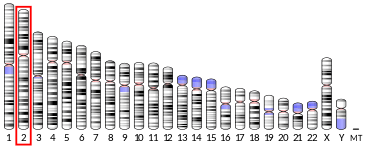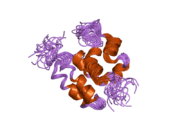COMMD1
COMM domain-containing protein 1 is a protein that is encoded by the COMMD1 gene in humans. It was originally regarded as Murr1 before being differentiated and renamed by Dr. Ezra Burstein's Lab[5][6][7]
References
- GRCh38: Ensembl release 89: ENSG00000173163 - Ensembl, May 2017
- GRCm38: Ensembl release 89: ENSMUSG00000051355 - Ensembl, May 2017
- "Human PubMed Reference:". National Center for Biotechnology Information, U.S. National Library of Medicine.
- "Mouse PubMed Reference:". National Center for Biotechnology Information, U.S. National Library of Medicine.
- Nabetani A, Hatada I, Morisaki H, Oshimura M, Mukai T (Feb 1997). "Mouse U2af1-rs1 is a neomorphic imprinted gene". Mol Cell Biol. 17 (2): 789–98. doi:10.1128/mcb.17.2.789. PMC 231805. PMID 9001233.
- van De Sluis B, Rothuizen J, Pearson PL, van Oost BA, Wijmenga C (Jan 2002). "Identification of a new copper metabolism gene by positional cloning in a purebred dog population". Hum Mol Genet. 11 (2): 165–73. doi:10.1093/hmg/11.2.165. PMID 11809725.
- "Entrez Gene: COMMD1 copper metabolism (Murr1) domain containing 1".
External links
- Human COMMD1 genome location and COMMD1 gene details page in the UCSC Genome Browser.
Further reading
- Maruyama K, Sugano S (1994). "Oligo-capping: a simple method to replace the cap structure of eukaryotic mRNAs with oligoribonucleotides". Gene. 138 (1–2): 171–4. doi:10.1016/0378-1119(94)90802-8. PMID 8125298.
- Suzuki Y, Yoshitomo-Nakagawa K, Maruyama K, et al. (1997). "Construction and characterization of a full length-enriched and a 5'-end-enriched cDNA library". Gene. 200 (1–2): 149–56. doi:10.1016/S0378-1119(97)00411-3. PMID 9373149.
- Harrington JJ, Sherf B, Rundlett S, et al. (2001). "Creation of genome-wide protein expression libraries using random activation of gene expression". Nat. Biotechnol. 19 (5): 440–5. doi:10.1038/88107. PMID 11329013.
- Strausberg RL, Feingold EA, Grouse LH, et al. (2003). "Generation and initial analysis of more than 15,000 full-length human and mouse cDNA sequences". Proc. Natl. Acad. Sci. U.S.A. 99 (26): 16899–903. doi:10.1073/pnas.242603899. PMC 139241. PMID 12477932.
- Müller T, van de Sluis B, Zhernakova A, et al. (2003). "The canine copper toxicosis gene MURR1 does not cause non-Wilsonian hepatic copper toxicosis". J. Hepatol. 38 (2): 164–8. doi:10.1016/S0168-8278(02)00356-2. PMID 12547404.
- Tao TY, Liu F, Klomp L, et al. (2004). "The copper toxicosis gene product Murr1 directly interacts with the Wilson disease protein". J. Biol. Chem. 278 (43): 41593–6. doi:10.1074/jbc.C300391200. PMID 12968035.
- Klomp AE, van de Sluis B, Klomp LW, Wijmenga C (2004). "The ubiquitously expressed MURR1 protein is absent in canine copper toxicosis". J. Hepatol. 39 (5): 703–9. doi:10.1016/S0168-8278(03)00380-5. PMID 14568250.
- Biasio W, Chang T, McIntosh CJ, McDonald FJ (2004). "Identification of Murr1 as a regulator of the human delta epithelial sodium channel". J. Biol. Chem. 279 (7): 5429–34. doi:10.1074/jbc.M311155200. PMID 14645214.
- Ganesh L, Burstein E, Guha-Niyogi A, et al. (2004). "The gene product Murr1 restricts HIV-1 replication in resting CD4+ lymphocytes". Nature. 426 (6968): 853–7. doi:10.1038/nature02171. hdl:2027.42/62709. PMID 14685242.
- Burstein E, Ganesh L, Dick RD, et al. (2004). "A novel role for XIAP in copper homeostasis through regulation of MURR1". EMBO J. 23 (1): 244–54. doi:10.1038/sj.emboj.7600031. PMC 1271669. PMID 14685266.
- Stuehler B, Reichert J, Stremmel W, Schaefer M (2005). "Analysis of the human homologue of the canine copper toxicosis gene MURR1 in Wilson disease patients". J. Mol. Med. 82 (9): 629–34. doi:10.1007/s00109-004-0557-9. PMID 15205742.
- Gerhard DS, Wagner L, Feingold EA, et al. (2004). "The status, quality, and expansion of the NIH full-length cDNA project: the Mammalian Gene Collection (MGC)". Genome Res. 14 (10B): 2121–7. doi:10.1101/gr.2596504. PMC 528928. PMID 15489334.
- Burstein E, Hoberg JE, Wilkinson AS, et al. (2005). "COMMD proteins, a novel family of structural and functional homologs of MURR1". J. Biol. Chem. 280 (23): 22222–32. doi:10.1074/jbc.M501928200. PMID 15799966.
- Coronado VA, Bonneville JA, Nazer H, et al. (2006). "COMMD1 (MURR1) as a candidate in patients with copper storage disease of undefined etiology". Clin. Genet. 68 (6): 548–51. doi:10.1111/j.1399-0004.2005.00524.x. PMID 16283886.
- Zhang Z, Joh K, Yatsuki H, et al. (2006). "Comparative analyses of genomic imprinting and CpG island-methylation in mouse Murr1 and human MURR1 loci revealed a putative imprinting control region in mice". Gene. 366 (1): 77–86. doi:10.1016/j.gene.2005.08.020. PMID 16305817.
- de Bie P, van de Sluis B, Burstein E, et al. (2006). "Characterization of COMMD protein-protein interactions in NF-kappaB signalling". Biochem. J. 398 (1): 63–71. doi:10.1042/BJ20051664. PMC 1525016. PMID 16573520.
- Sommerhalter M, Zhang Y, Rosenzweig AC (2007). "Solution structure of the COMMD1 N-terminal domain". J. Mol. Biol. 365 (3): 715–21. doi:10.1016/j.jmb.2006.10.030. PMC 2706016. PMID 17097678.
- Maine GN, Mao X, Komarck CM, Burstein E (2007). "COMMD1 promotes the ubiquitination of NF-kappaB subunits through a cullin-containing ubiquitin ligase". EMBO J. 26 (2): 436–47. doi:10.1038/sj.emboj.7601489. PMC 1783443. PMID 17183367.
This article is issued from Wikipedia. The text is licensed under Creative Commons - Attribution - Sharealike. Additional terms may apply for the media files.






